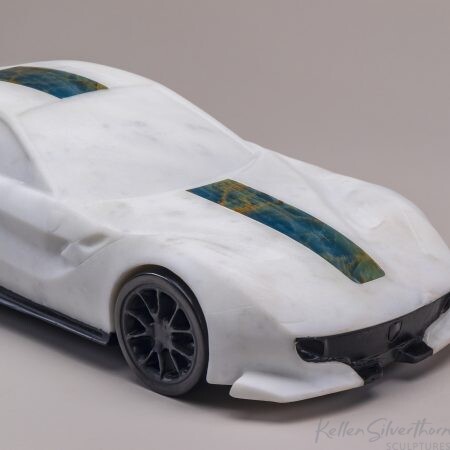SARI’S SURPRISE – inspired by the Ferrari F12 TdF
hover and click over individual sculpture photographs to enlarge
THE CAR
Since the retirement of the mid-engined flat-12 Testarossa in 1996 Ferrari has reverted to front-engine placement for its core V-12 product, the two-seat Grand Tourer (Maranello to 2006, then 599 to 2012, then F12 to 2017, and now 812). Ferrari has minted a number of limited-edition hotrods based on these modern core 2-seat front-engined V12 models. These include the 599-based GTO, F12-based TdF, and 812 Monza SP.
The Enzo’s Tipo F140 65 degree V-12 engine has evolved to power all of the V-12 models since. In the naturally aspirated F12 it measures 6.3L. In the core F12 model the engine produces 730 hp, while in the hotrod TdF it generates 769 hp.
Among Ferraris only the LaFerrari and today’s 812 Superfast are more powerful.
The V-12 in the F12 transmits its power to the rear wheels through a paddle-shifted 7-speed dual-clutch automated-shift transaxle. F12s are built around an aluminum space frame chassis co-developed with Scaglietti. As per usual Ferrari practice, the F12 body is a Pininfarina design,( tweaked further by Ferrari Design for the TdF). The F12 chassis improves structural rigidity by 20% over the 599, whilst reducing weight by 150 lb. The hot rod TdF F12 sheds another 243 pounds. Other technology employed includes carbon ceramic disc brakes, magnetorheological dampers, and a suite of electronic chassis aids.
The track-focused F12 TdF version was unveiled in October 2015. The name pays homage to the Tour de France automobile race held between 1899 and 1986. In the 1950s and 1960s this was a multi-day competition of tarmac stage rally, and circuit track racing, with public road transit stages inter-connecting. A series of iconic Ferrari 250 dual-purpose models were the perennial winners between 1956 and 1964.
The modern TdF model has recorded a 1 minute 21 seconds lap time on Ferrari’s Fiorano test circuit. That time is 2 seconds faster than the core F12, and just 1.3 seconds behind the fastest lap set by the LaFerrari hybrid-drive hypercar.
Production of the F12 TdF was limited to 799 units.
THE STONE
This sculpture was essentially a portrait of a Ferrari collector’s prized possession. The best match of colors for that car was Statuario for the white body panels, blue onyx for the central stripe, and Belgian Black (a.k.a. Belge Noir) for the trim and wheel / tire units.
The white and the black marbles I have worked with before. Both are benchmark stone types within the sculptor community. Both have excellent characteristics to work with, though the black is notable for how hard it is. That hardness takes its toll on tooling and finger tips!
While most marble gets polished to 2500 grit, Statuario has a great look at 200-300 grit which many sculptors embrace…. smooth, matte, with tiny focal sparkles of light reflection.
Blue Onyx was a first for me, but it presented no special challenges. I look forward to using it again, (perhaps for a D-Type Jag, or Ferrari Daytona). I look forward to further “portraits”, for this same collector, or any single-marque collectors who step forward.
Most modern exotics are mid-engined….. Lamborghini, McLaren, Pagani, Ford GT, and now even the Corvette. Our brains have a ready sense of their missile-like profiles. With the TdF, Ferrari aims for the same level of visual impact, but from a front-engine layout. Not an easy task.
Prior to this project I hadn’t really appreciated the adventuresome body contours Ferrari risked panel-by-panel with the F12 TdF to achieve such dramatic styling effects. Using hand tools to shape the Carrera marble to mimic the design team’s contours impressed upon me their mastery. Kudos to Ferrari’s design chief Flavio Manzoni and both his in-house and outside collaborators at Pininfarina. And Viva la front-engine difference!







